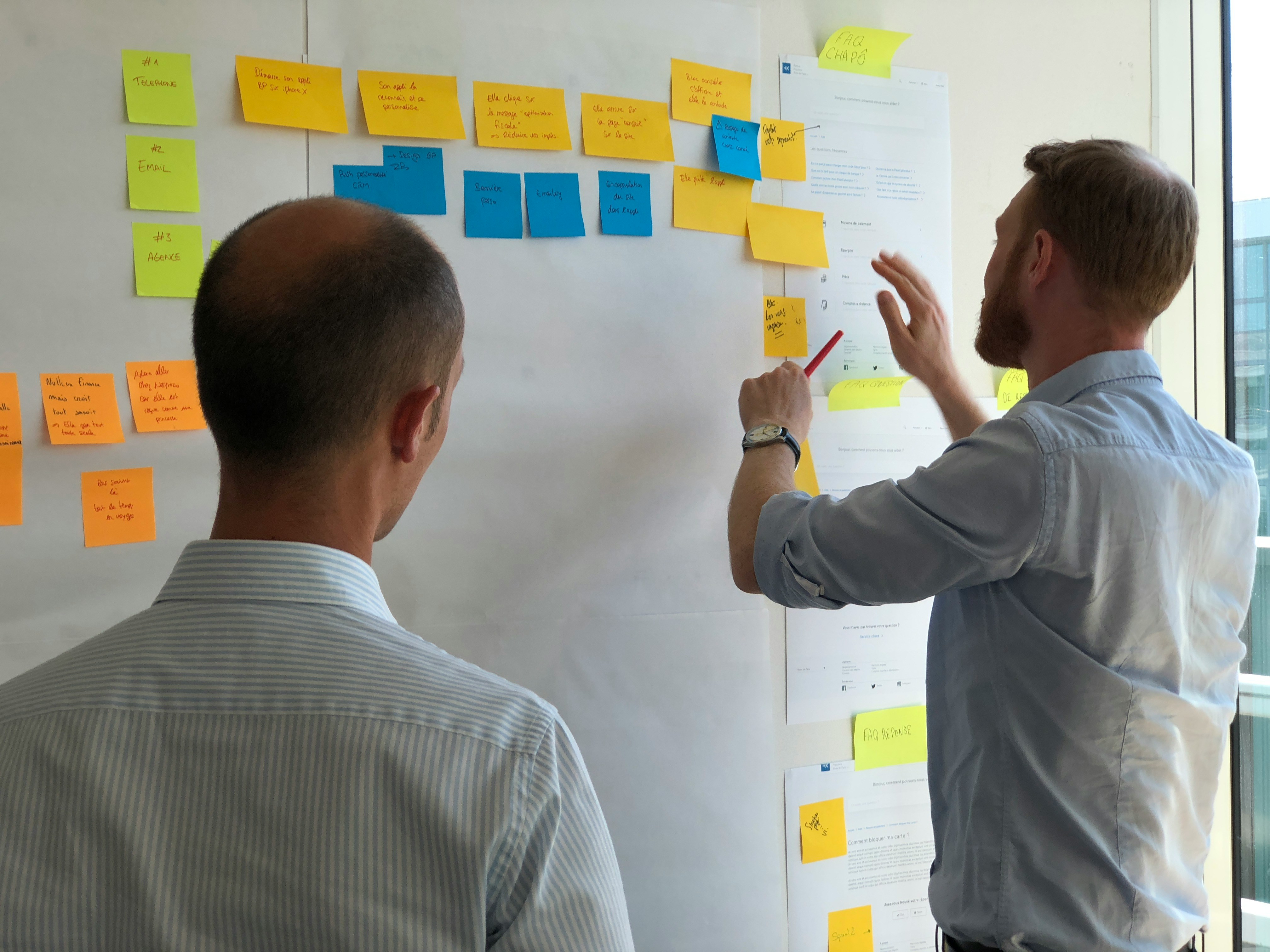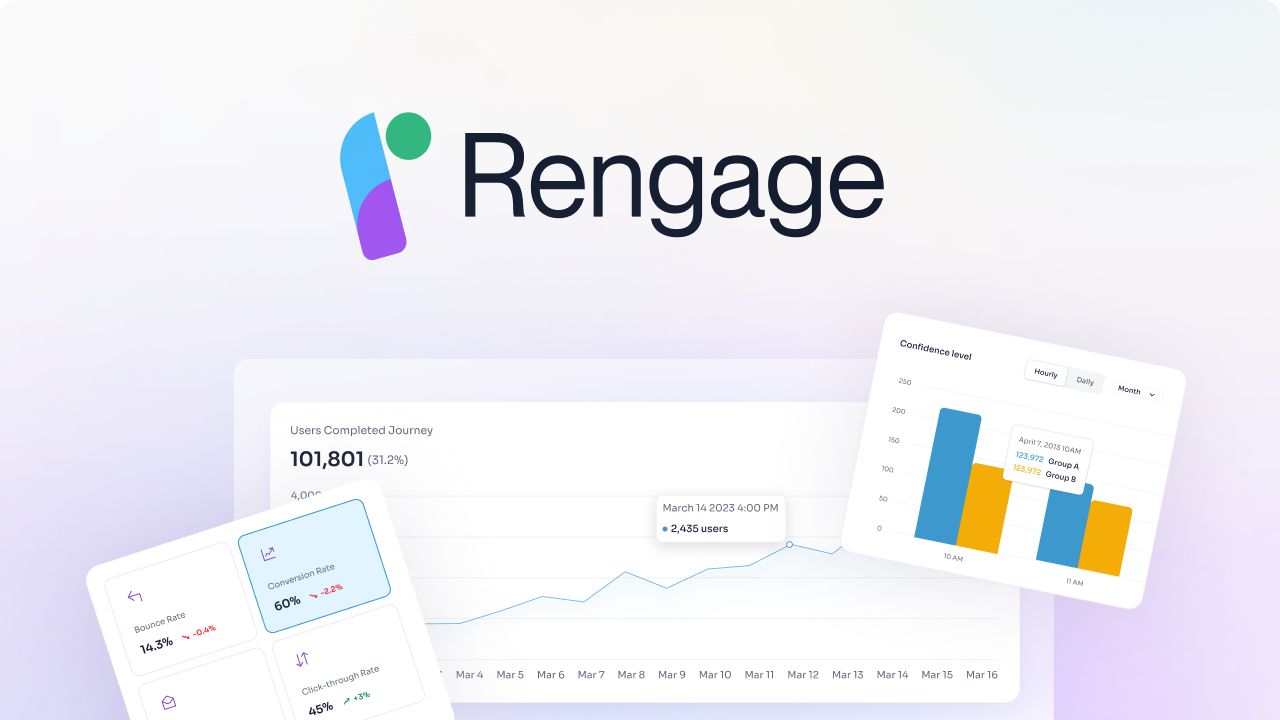Optimizing the customer journey is more than just a trend; it is a fundamental aspect of customer lifecycle management that can genuinely transform business outcomes. Ensuring that your customers have a seamless and satisfying experience at every touchpoint is crucial for maximizing your revenue and customer loyalty. Thanks to the digital age, there is an abundance of data available for companies to understand their customer's behavior and preferences. This information can be used to optimize the customer journey, reduce friction, and provide a more personalized experience.
What Is Customer Journey Optimization?

CJO is about putting oneself in the customer’s shoes to comprehend their needs, preferences, and pain points. It’s an ongoing process that involves collecting and analyzing data across all customer interactions to identify areas of improvement and opportunities to delight customers.
5 Key Elements of Customer Journey Optimization

1. Customer Journey Strategy Roadmap
Developing a customer journey strategy roadmap is the first crucial element in optimizing the customer journey. This roadmap outlines the route you need to take to achieve your desired outcomes. Essentially, it is a detailed plan that guides organizations step by step to execute their customer journey optimization strategies based on their business objectives and other relevant factors.
2. Customer Journey Analytics
Customer journey analytics delve into the data customers generate during their journey with your brand. This data is invaluable as it provides insights into customer behavior and preferences, allowing organizations to make informed decisions. Analytics equip organizations with the ability to turn raw data into actionable insights, which are essential for optimizing the customer journey.
3. Customer Journey Mapping
Customer journey mapping is the process of visualizing and understanding the key paths customers take when interacting with a brand. This element involves creating a map that outlines the touchpoints and interactions a customer has with your organization. By mapping the customer journey, you can identify pain points, opportunities, and areas for improvement, aiding in optimizing each step of the customer journey.
4. Customer Journey Orchestration
Customer journey orchestration is a critical component of customer journey optimization. This element focuses on delivering the right message to customers at the right time. It entails using data and insights gained through analytics and mapping to create personalized experiences for customers in real-time. Effective customer journey orchestration ensures that brands can act on insights swiftly, delivering relevant messages and experiences that resonate with customers.
5. Seamless Multi-Channel Experience
Customers interact with brands across multiple touchpoints, such as websites, social media, and physical stores. Ensuring a seamless transition and consistent experience across these channels is vital for brands looking to provide an integrated and satisfactory customer journey. Consistency is key, as customers should encounter a cohesive brand presence and messaging, regardless of the channel they choose for interaction. This element underscores the importance of aligning branding elements, communication styles, and aesthetics across platforms.
Maximizing Customer Engagement and Conversion with Rengage
We provide a comprehensive solution for managing and enhancing customer journeys, delivering insights and measurable outcomes with no code. We accelerate your customer journey from onboarding, activation to conversion and churn. Enabling customers to unlock revenue from their existing user.
With Rengage, you can get insights into your segments, run campaigns with an intuitive journey manager, and get insights to measure how your journeys impact users conversion through our Journey Moments and Journey Builder features.
- Journey Moments: insights into your micro-segments
- Journey Builder: intuitive multi-channel marketing automation, Insights prediction and attribution.
Book a free demo to learn about how you can transform customer interactions into personalized experiences that drive loyalty and growth.
Related Reading
8 Benefits of Customer Journey Optimization

1. Enhanced Customer Experience
A well-optimized journey ensures a smooth, enjoyable experience for customers. For instance, a streamlined online shopping process with easy navigation and quick checkout can leave customers feeling positive about a retail brand, encouraging repeat business.
2. Increased Customer Loyalty and Retention
Satisfied customers are more likely to be loyal and make repeat purchases. A software company providing excellent ongoing and proactive support can maintain a loyal customer base, reducing churn.
3. Higher Conversion Rates
A customer journey that is intuitive and tailored to user needs can significantly boost conversion rates. For example, an e-commerce website using personalized recommendations based on browsing history can lead to more customers making purchases.
4. Positive Word-of-Mouth and Brand Advocacy
Happy customers often become brand advocates. A fitness brand that engages with its customers and provides them with valuable health tips can see an increase in referrals and positive reviews.
5. Valuable Insights from Customer Feedback
Optimizing the customer journey involves listening to customer feedback, which can provide valuable insights for future improvements. A restaurant chain that actively solicits and acts on customer feedback can continually enhance its menu and service quality.
6. Competitive Advantage
A business that provides a superior customer journey can stand out from its competitors. A mobile phone carrier offering transparent pricing and excellent customer service can differentiate themselves in a highly competitive market.
7. Improved Customer Lifetime Value (CLV)
A better customer experience leads to increased customer loyalty, resulting in a higher CLV. A car dealership with an exceptional after-sales service and loyalty program could see customers returning for their next car purchase.
8. Efficient Resource Utilization
By understanding and optimizing the customer journey, businesses can allocate resources more efficiently. An online retailer analyzing customer behavior can better stock products and plan marketing campaigns, reducing waste and increasing profitability.
6 Key Metrics for Customer Journey Optimization

1. Customer Satisfaction (CSAT) Score
Customer satisfaction score is used to measure customer satisfaction with the product, service, and overall experience. This metric typically involves customers rating their satisfaction on a scale from 1 to 5 or 1 to 10. It helps businesses understand how well they are meeting customer expectations and where improvements may be needed.
2. Net Promoter Score (NPS)
Net Promoter Score is a metric used to measure customer loyalty towards a brand, product, or service. It gauges the likelihood of customers recommending the brand to others. Customers are segmented into detractors, passives, and promoters based on their ratings. A high NPS signifies satisfied customers who are likely to become repeat customers and advocates for the brand.
3. Customer Effort Score (CES)
Customer effort score is a metric used to measure how easy it is for customers to interact and engage with your brand, product, or service. It helps businesses understand how effortless customers find the support or service experience. A lower CES indicates a better customer experience and a higher likelihood of customer retention.
4. Conversion Rate
Conversion rate is a metric that measures the number of customers who have moved down the sales funnel and completed a desired action. This could be making a purchase, signing up for a newsletter, or requesting more information. A high conversion rate indicates effective customer journey optimization that successfully guides customers through the sales process.
5. Customer Churn Rate
Customer churn rate is a metric that measures the percentage of customers who have stopped interacting, engaging, and using your brand, product, or service. By tracking customer churn, businesses can identify pain points in the customer journey that lead to dissatisfaction or disengagement. A high churn rate signals the need for improvements in customer experience and journey optimization.
6. Customer Lifetime Value (CLV)
Customer lifetime value is a metric used to measure the total net profit a business can generate from a customer throughout their lifetime or relationship with the company. By understanding the CLV, businesses can allocate resources effectively to acquire and retain high-value customers. A higher CLV indicates that a business is successfully optimizing the customer journey to create long-term, profitable relationships.
Related Reading
- Digital Customer Journey Mapping
- Customer Journey Analysis
- Ecommerce Customer Journey
- B2B Customer Journey
- Customer Journey Orchestration
- Omnichannel Customer Journey
- Saas Customer Journey
- Marketing Automation Customer Journey
- Micro Moments Customer Journey
- Customer Journey Research
- Customer Journey Automation
- Customer Journey Insights
- Customer Journey Dashboard
- Customer Journey Personalization
- Customer Journey Metrics
- Customer Journey Best Practices
17 Top Tools for Effective Customer Journey Optimization
1. Rengage

We provide a comprehensive solution for managing and enhancing customer journeys, delivering insights and measurable outcomes with no code. We accelerate your customer journey from onboarding, activation to conversion and churn. Enabling customers to unlock revenue from their existing user.
With Rengage, you can get insights into your segments, run campaigns with an intuitive journey manager, and get insights to measure how your journeys impact users conversion through our Journey Moments and Journey Builder features.
- Journey Moments: insights into your micro-segments,
- Journey Builder: intuitive multi-channel marketing automation, insights prediction and attribution.
Book a free demo to learn about how you can transform customer interactions into personalized experiences that drive loyalty and growth.
2. Aiava
A modeling tool for customer journeys that uses storytelling as a framework. Features include:
- Text-to-visual design
- Rich media content attachments
- Multiple map views
- Scenario walking.
Collaboration features include comments, suggestions, and pain-point marking.
3. Custellence
For customer experience (CX) teams interested in service blueprints and journey maps. Uses a “lane-based interface” with a drag-and-drop cards structure for more customization. Includes templates for a range of processes and journeys. Presentation settings offer view control.
4. Flowmapp
A visual platform for planning, designing, and mapping sitemaps, user flows, content hierarchies, information architecture, and project wireframes. Includes templates, workspace organization, import/export formats, real-time commenting for collaboration, and project-specific statuses.
5. JourneyTrack
A customer journey management platform that includes persona and workshop support. Features include an atlas to weave journeys through other processes (such as funnels), metrics and data visualization, opportunity scoring (via a jobs-to-be-done framework), and integration with prototyping, database, and repository tools.
6. ShiftX
Offers business process mapping (BPM), including customer or user journeys. Features include:
- Robust onboard keyboard shortcut system
- Automatic map flow layout designer
- Customizable persona creation
- Real-time visual collaboration
- Issue categorization to identify ongoing pain points.
7. Smaply
Has two version: classic (currently live) and a forthcoming “3.0” version (access granted in batches). The classic version offers design and management of journeys, personas, and stakeholder maps. Journey mapping features include:
- Repository
- Hierarchy assignments
- Integrations with project management software
- Customizable exports
8. Theydo
Focuses on journey management: mapping, structuring in a framework, and uncovering opportunities across them. Includes a template library for blueprints, funnels, lifecycles, and even roadmaps. Offers integrations with different tools categories, including analytics, design/prototyping, product and project management, and impact tracking
9. UXPressia
Create customer journey maps, user personas, and map the impact of your product. Offers a repository for the assets needed to create and manage maps, such as statuses and tags.
Additional features include:
- Journey-specific taxonomies
- Cross-team collaboration
- Standardization for new maps
- Templates for a variety of journey types.
10. CleverTap
For creating personalized product experiences, in-app experiments, optimizations, and broader campaign creation (including journeys). Offers multiple customer data collection streams and analysis approaches, including some leveraging artificial intelligence. Offers industry-specific features for SaaS and gaming companies.
11. Contentsquare
A digital experience platform (DXP) focused on capturing and centralizing customer analytics data for use in creating journeys, user segments, heatmaps, and sessions. Has three core feature areas:
- Analytics (heat maps and journeys)
- Monitoring (error and speed analyses)
- Product analytics (retention reporting and segmentation).
12. Churnzero
Customer success software focused on customer engagement and retention. Offers features around customer data (profiles and segmentation), analysis (health scores and renewal forecasting), collaboration (journeys and in-app messaging), revenue forecasting (advanced reporting and in-app surveys) and robust workflow creation and automation.
13. Glassbox
Focused on creating a complete profile of customer engagement and retention across any digital property. Their tool suite includes:
- Mobile app analytics
- Journey analysis
- Session capture and replay
- Interaction maps, funnel creation
- Performance metrics
- Voice-of-customer engagements
- Artificial intelligence for real-time support and guidance
14. Milkymap
A CX platform focused specifically on journey map creation, development, and management. They offer a framework for structuring customer experience metrics and bring them into journey mapping design. Offers APIs to connect other data streams, a variety of visualization styles, and KPI integration for team-wide alignment and collaboration.
15. MoEngage
An insights-focused experience management and engagement platform. Features enable:
- The collection of customer data
- Journey orchestration and mapping
- Website personalization
- Omnichannel communication
- Artificial intelligence campaign optimization
- Real-time purchase transaction alerts via an API.
16. Planhat
A “horizontal” customer platform for post-sales engagement and management. The tool is organized around four actions:
- Centralizing customer data for a 360 view
- A no-code way to create automations, triggers, and alerts via bots and integrations
- Building journeys that combine tasks with conditional sequencing
- A presentation suite to share findings and stories
17. WebEngage
A retention operating system for unifying customer data to personalization and automate campaigns. Offers tools:
- Create customer profiles via data integrations
- Design paths, funnels, or cohorts
- Orchestrate user journeys
- Surface notifications based on segmentation
- Communicate via app, web, email or various ads platforms.
5 Ways to Measure the Success of Customer Journey Optimization

1. Key Performance Indicators (KPIs)
Understanding the success of customer journey optimization involves tracking metrics like conversion rate, customer satisfaction, retention rate, and lifetime value. These KPIs provide a clear picture of how the optimization efforts are positively impacting the customer journey.
2. Customer feedback
Customer feedback is a critical component of assessing customer journey optimization success. Methods like surveys and focus groups help collect customer opinions about their journey experience and what can be improved.
3. Analytics
Utilizing analytics tools can offer deep insights into how customers engage with the business and where potential issues may arise. By analyzing this data, it becomes easier to identify areas that need improvement and monitor progress over time.
4. A/B testing
A/B testing is a valuable tool for optimizing customer interactions. By testing different versions of websites, emails, or other touchpoints, businesses can hone in on what works best for their customers, thus gauging the effectiveness of their optimization efforts.
5. Comparative analysis
Comparing the business's performance with that of competitors gives a clearer understanding of how well the optimization efforts resonate with the customer base. By identifying areas that need improvement, businesses can stay ahead of the competition and maintain a strong position in the market.
By incorporating these methods, businesses can accurately gauge the success of their optimization efforts and continuously improve the customer journey.
6 Common Pitfalls to Avoid in Customer Journey Optimization

1. Focusing on the wrong touchpoints
It's important to focus on the touchpoints that matter most to your customers. Spending time and resources optimizing touchpoints that have little impact on the overall customer experience isn't productive. We need to identify the touchpoints that are most crucial to the customer journey and concentrate our efforts there.
2. Overlooking the big picture
The customer journey isn't just about optimizing individual touchpoints. We must create a seamless experience across all touchpoints. Don't be so focused on individual touchpoints that we fail to see how they work together. Think about how all the touchpoints work in tandem to build a bigger picture.
3. Lack of data
Data is a critical component of successful customer journey optimization. Without it, we can't understand customer behavior or make informed decisions about optimizing touchpoints. Neglecting to consider the importance of data in our optimization efforts can lead to flawed strategies.
4. Failing to personalize
Personalization is essential in great customer journeys. Relying on generic messaging or one-size-fits-all solutions won't cut it anymore. Use data to create innovative, personalized experiences that cater to individual customer needs and tastes.
5. Neglecting customer feedback
Gathering feedback from customers is a key part of successful customer journey optimization. Neglecting customer feedback means missing out on valuable insights into areas where the customer experience can be improved. Customer feedback is a goldmine of information waiting to be unearthed.
6. Not iterating
Optimization is an ongoing process. Don't think that you can optimize the customer journey once and be done with it. Continuously testing and iterating to find new areas for improvement is crucial for keeping our optimization efforts relevant.
Create Personalized Experiences That Drive Loyalty and Growth with Rengage — Book A Free Demo Today
When it comes to maximizing customer journey optimization, Rengage is your ultimate solution. Rengage equips you with a powerful tool to manage and enhance customer journeys seamlessly. The platform provides comprehensive insights and measurable outcomes effortlessly without requiring any coding. We streamline the customer journey from onboarding to activation, conversion, and churn, allowing you to unlock maximum revenue from your existing user base.
Enhanced Customer Engagement and Insights
With Rengage, you gain unparalleled visibility into your customer segments and can seamlessly run campaigns using an intuitive journey manager. The platform provides a robust suite of features, including Journey Moments and Journey Builder, which offer insights into micro-segments and facilitate multi-channel marketing automation respectively. What's more, Rengage also leverages insights prediction and attribution to help you measure the impact of your journeys on user conversion.
Transform Customer Interactions
To leverage all these capabilities and transform customer interactions into personalized experiences that drive loyalty and growth, book a free demo with us today.
Take the first step towards optimizing your customer journey and unlocking unprecedented growth opportunities with Rengage.
Related Reading
- Customer Lifecycle Management Software
- Customer Journey Mapping Tools
- Customer Journey Management
- Braze Alternative
- Fullstory Alternatives
- Adobe Analytics Alternatives
- Customer Journey Analytics Tools
- Iterable Competitors
- Marketo Alternatives
- Onesignal Alternatives
- Clevertap Alternatives
- Bloomreach Alternatives
- Customer.io Alternatives
